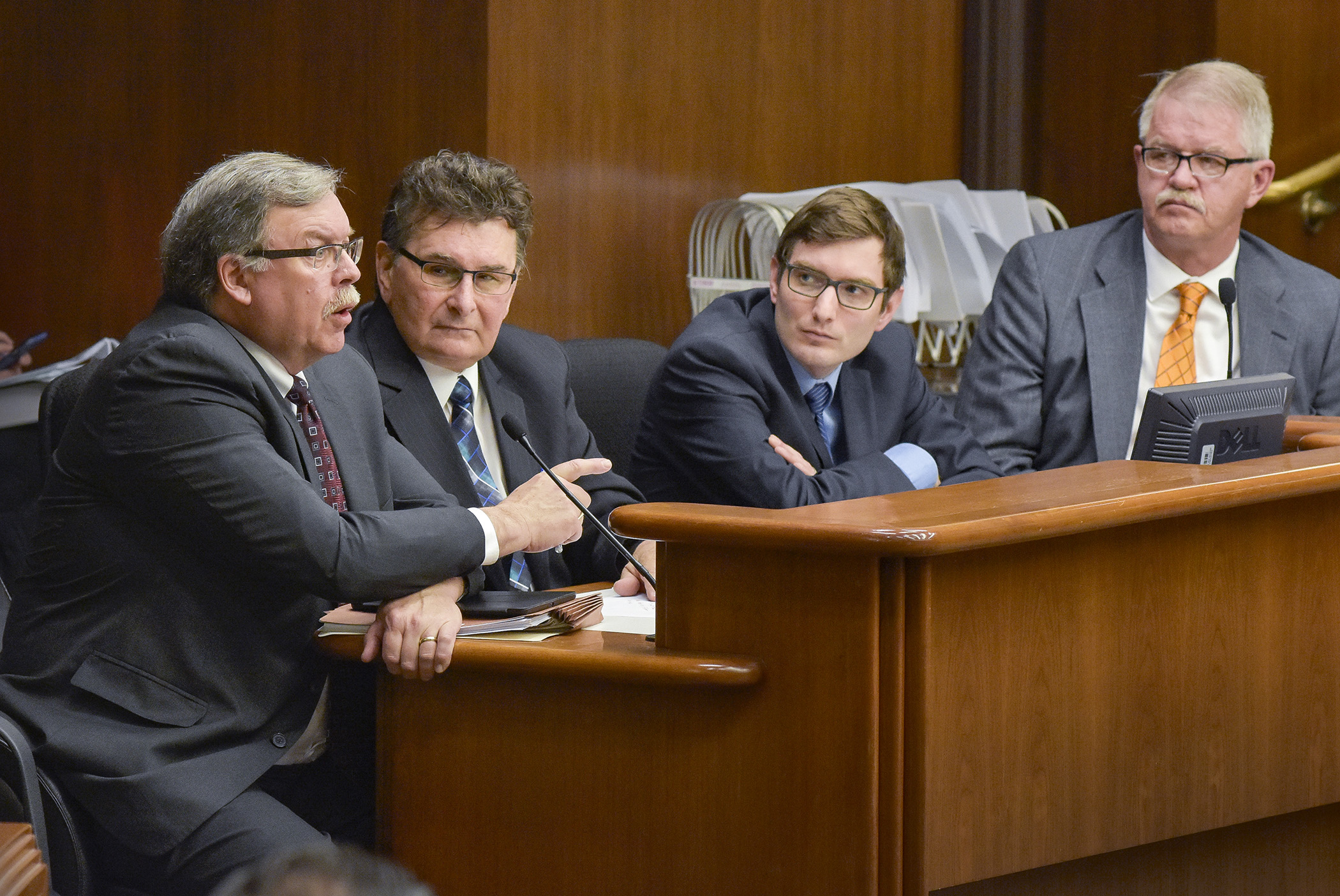Committee approves bill to restructure Iron Range development board

Sitting shoulder to shoulder in front of the House Government Operations and Elections Policy Committee Wednesday, House members from the Iron Range voiced their opposition to a bill that would dismantle a board on which they serve and require legislative approval of millions of dollars targeted to improve economic diversity in their region.
Sponsored by Rep. Tom Hackbarth (R-Cedar), HF3925 would abolish the Iron Range Resources and Rehabilitation Board in July 2017, replacing it with a nine-member commission that would evaluate and make recommendations on budget proposals and appropriations for money raised primarily from a tax on mineral production in the area.
The committee approved the bill, which has no Senate companion, on a 10-5 roll-call vote and referred it to the House Civil Law and Data Practices Committee.
Created in 1941, the IRRRB provides loans and grants to businesses, municipalities and nonprofit organizations on the Iron Range to help create economic diversification in northeast Minnesota.
According to a 2015 report from the Office of the Legislative Auditor, the Fiscal Year 2015 budget for the IRRRB was $41 million. It also had access at the end of that fiscal year to $90.6 million in statutorily defined funds for grants and loans.
WATCH Committee discussion of the bill on YouTube
That same review found the agency’s oversight and evaluation of its loans and grants “inadequate” and that there was “limited evidence” they met their objectives. The auditor also found that the structure of the agency itself is vulnerable to constitutional challenge.
“The bill is here primarily because we want to give this some clarity, some transparency, some accountability with what’s happening to the money moving through the IRRRB,” Hackbarth said.
However, Rep. Tom Anzelc (DFL-Balsam Township), who sits on the IRRRB, said the auditor’s report did not speak to the quality or the wisdom of the loans, but to compliance and monitoring issues. He agreed that some changes were needed, but said efforts to make those is already underway.
Anzlec also repeatedly made the point that money the IRRRB distributes comes from a tax on mineral production, which mining companies pay in lieu of property taxes. He argued that giving the Legislature authority to approve how his region’s “property taxes” are spent would be without precedent anywhere else in the state.
“We feel this bill, when a budget has to come before the Legislature for approval, would essentially handcuff all of our communities,” Anzelc said. “These dollars should be spent by local officials.”
Constitutional questions
The auditor’s report also questioned the IRRRB’s governance structure, calling it “unique in state government” because legislators have “substantive power” over what is an executive branch agency. Although the governor appoints a commissioner to head the agency, the board itself is composed of nine legislators.
Legislative Auditor Jim Nobles told the committee he believed “the constitutional question is really what I think gives rise to the legislation before you. This is a very unique organization.”
Key provisions of HF3925
The commission that would be formed under HF3925 would be comprised of three House members, three senators and three public members. Unlike the IRRRB, there would be no requirement that members be from the Iron Range.
The auditor’s report recommended the IRRRB should do more to ensure loans will create jobs, more consistently examine how well grants meet stated objectives and regularly analyze the impact of loans and grants on the area the IRRRB serves. Several new requirements for grants and loans set forth in HF3925 are based on these recommendations.
The bill would also require Minnesota Management & Budget to study the future of Giants Ridge Recreation Area near Biwabik, which the IRRRB currently owns. MMB would be directed to look at a sale of the property or transferring it to the Department of Natural Resources.
Per the legislative auditor’s report, “IRRRB has subsidized Giants Ridge operations by $17.4 million from 2006 through 2014 — an average of $1.9 million annually. Over this period, IRRRB also paid $6.7 million for Giants Ridge capital investments and $19.8 million to retire bond debt.”
Hackbarth said the bill would not do anything to reduce the amount of money going to the Iron Range, but would provide more oversight and accountability.
“I think this bill not only addresses the constitutional issues, but also where this money is going and how it’s spent,” Hackbarth said. “I think everyone on the Iron Range should be concerned about that.”
But Rep. Jason Metsa (DFL-Virginia), who also sits on the IRRRB, said that if the legislation was meant to help, people in the area should have been consulted about it.
“To my knowledge not one member of any community was reached out to, whether it be a local mayor, county commissioner, to help give input into what I would consider to be a very large change and way of doing business,” Metsa said. “A lot of communities are very nervous about what this language would mean.”
Related Articles
Search Session Daily
Advanced Search OptionsPriority Dailies
Ways and Means Committee OKs proposed $512 million supplemental budget on party-line vote
By Mike Cook Meeting more needs or fiscal irresponsibility is one way to sum up the differences among the two parties on a supplemental spending package a year after a $72 billion state budg...
Meeting more needs or fiscal irresponsibility is one way to sum up the differences among the two parties on a supplemental spending package a year after a $72 billion state budg...
Minnesota’s projected budget surplus balloons to $3.7 billion, but fiscal pressure still looms
By Rob Hubbard Just as Minnesota has experienced a warmer winter than usual, so has the state’s budget outlook warmed over the past few months.
On Thursday, Minnesota Management and Budget...
Just as Minnesota has experienced a warmer winter than usual, so has the state’s budget outlook warmed over the past few months.
On Thursday, Minnesota Management and Budget...